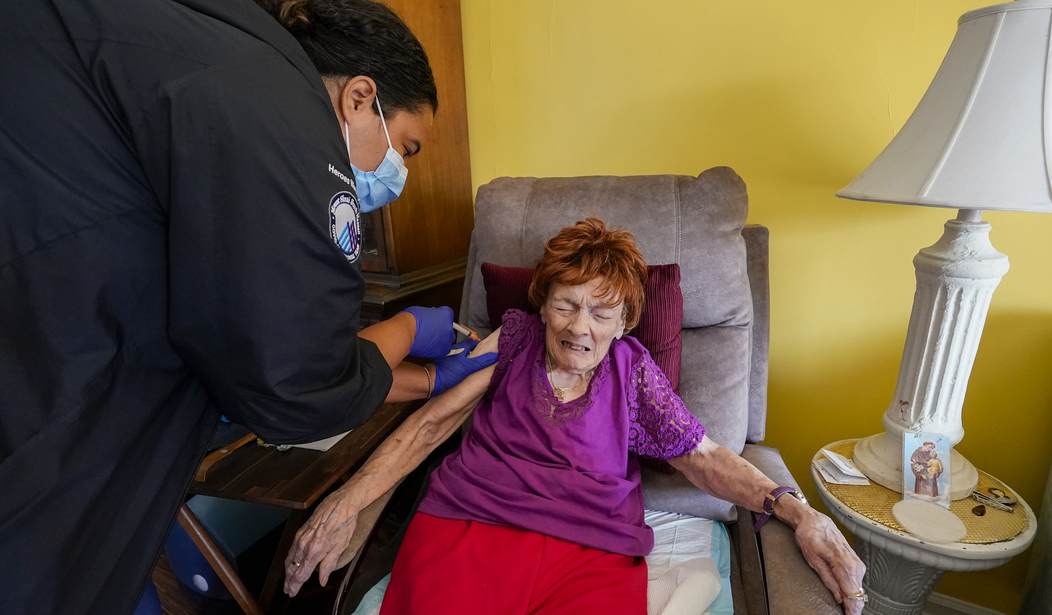I might be guilty of nitpicking here, but based on the way the media has hyped the ever-loving crap out of COVID-19 from the outset, I might not. First, here’s the reality — and I’ll use The Wall Street Journal’s own words: “The Delta wave of the Covid-19 pandemic is past its peak, with new cases, hospitalizations and deaths declining in most states. … all of [the] metrics are improving significantly at the national level.”
Great news, right?
Here’s the WSJ’s headline on its report of the good news:
Delta Surge of Covid-19 Recedes, Leaving Winter Challenge Ahead
What is that? “Hey, great news on the Delta variant! Here’s why that’s bad news!”
The Delta wave of Covid-19 cases is abating across most of the U.S. Health officials say boosting vaccination rates is key to maintaining that momentum. https://t.co/EnSLiN7oAu
— The Wall Street Journal (@WSJ) October 31, 2021
Despite the wording of the WSJ headline, the news in the article and elsewhere was the best COVID news we’ve heard in recent months. Except for the warning thing, that is.
Excerpts (emphasis, mine):
Case counts from the Delta surge were declining by mid-September after peaking above 160,000 a day, Johns Hopkins data show.
The seven-day new case average was down about 16% this past Tuesday from the week prior, Centers for Disease Control and Prevention Director Rochelle Walensky said, citing CDC data.
Covid-19 hospitalizations, which surged to records in many states as the highly infectious Delta variant spread chiefly among the unvaccinated, are down about 54% from a late-August peak.
The Delta-fueled wave continues to take a serious toll, but the seven-day average in reported deaths has dropped to roughly 1,400 a day from daily averages above 2,000 in late September, Johns Hopkins data show.
“We may be at a turning point,” said Marcus Plescia, chief medical officer at the Association of State and Territorial Health Officials. “We have a lot more tools now to fight it.”
The WSJ also quoted Jason Salemi, an associate professor of epidemiology at the University of South Florida:
“It’s a lot tougher for Delta to hop from person to person because so many people were infected.”
But, as the WSJ warned, a dark cloud remains in front of that silver-lining news — beginning with the winter holiday season last year.
There are reasons for caution, health authorities say. The U.S. posted its worst numbers of the pandemic, including a quarter-million new cases a day, shortly after the winter holidays last year, when colder weather and family gatherings brought more people together indoors where the virus most easily spreads.
OK, but the WSJ just quoted two experts, one of whom said we have a lot more tools to fight the virus, now, and the other one said it’s a lot harder to spread the Delta variant now, because so many people have already been infected with it. Yeah, I’m confused.
The WSJ then cited the number of Americans who haven’t been vaccinated to further make its ominous case about the coming holiday season.
Roughly one-third of the U.S. population has yet to get a single vaccine dose. In a few states, including Idaho and West Virginia, roughly half the population hasn’t gotten a shot.
In Idaho, the Delta-driven surge appears to be cooling, but hospitals are still in crisis mode and local health officials said they have also seen at least one confirmed case of influenza.
Catch that? First, the WSJ points out that half of the people of Idaho haven’t been vaccinated is a bad thing, then says the Delta-driven surge in the state is cooling. But — but — but… hospitals are still in crisis mode and one Idahoan caught the flu! [rolling-eyes emoji]
And the dark cloud in front of the silver lining? “There are reasons for caution,” according to the WSJ. Aren’t there always reasons, when talking about COVID? Until the end of humanity?
There are reasons for caution, health authorities say. The U.S. posted its worst numbers of the pandemic, including a quarter-million new cases a day, shortly after the winter holidays last year [last year], when colder weather and family gatherings brought more people together indoors where the virus most easily spreads.
In the U.K., where the vaccination rate is higher than in the U.S., cases remain high after the country bet on immunity from vaccines and prior infections while dropping other measures like indoor crowd limits and mandatory mask-wearing.
Stop the tape. The vaccination rate in the U.K. is higher, but so are the number of cases? The WSJ is not making its case, here. And speaking of crowd limits and mandatory mask-wearing, why aren’t NFL stadiums that are packed with maskless fans turning into so-called superspreader events, liberals? I’ll wait.
Nonetheless, Christine Hahn, a state epidemiologist at the Idaho Department of Health and Welfare, worried at a press briefing, last week “[w]hether we’re going to see another spike this fall and winter, I think we’re worried that we can.”
So, what can we do? How can we impact whether that dark cloud remains or grows more ominous than the silver lining continuing to shine, as the Wall Street Journal sees it? Vaccinate more young kids, of course. I mean, little kids are germ-spreaders, anyway, right? So, why not?
The U.S. could further bolster its defenses as younger children begin to get vaccinated in the weeks ahead. The Food and Drug Administration on Friday authorized the Pfizer Inc. and BioNTech SE vaccine for some 28 million children ages 5 through 11. Shots could be available to children this coming week after a review by the CDC.
Speaking of vaccinating young kids, as we reported earlier this month, the People’s Republic of California [sarc, of course] became the first state in the nation to mandate vaccines for all kids aged five and older. In what CA Democrats are calling a “loophole” they vow to eliminate, the executive order allows students and staff to opt out for religious or ideological reasons.
Finally, the WSJ headline aside, the article ends with an upbeat quote from a Missouri epidemiologist:
“Even if future waves happen, they very likely are not going to be of the magnitude that we saw last November and December.”
Then again, liberals can — and will — cling to that dark cloud. With all of their politically expedient might.















Join the conversation as a VIP Member